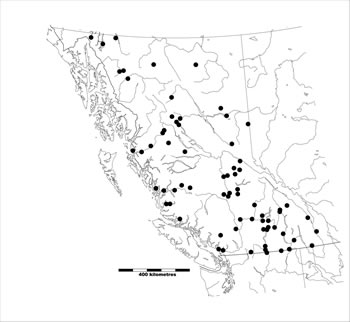The Porcupine is a distinctive large species of rodent covered in defensive quills, and is the second largest rodent in Canada (the Beaver is larger) (Resource Inventory Committee 1998). It is dark brown or black in colour (sometimes with yellow or white quills), with a humped back, small head, small ears, blunt nose, small eyes, short bowed legs, large curved claws, and a short thick tail (Gunn 2001, Nagorsen 2005). The pelage or coat is made up of long thick-barbed quills, guard hairs and a woolly undercoat (Nagorsen 2005). The quills are hidden by the guard hairs until raised in defence (Gunn 2001). Young porcupines are born with soft, barbless quills, but these harden within hours and can be erected not long after birth (Gunn 2001). An adult porcupine can have up to 30,000 quills (Gunn 2001, Nagorsen 2005). Griffin (2003) provides the following measurements for this species: (males) total length, 808 mm; tail, 235 mm; hind foot, 98 mm; (females) 737-230-81 mm, and the average weight is 5-11 kg. Males are larger than females.
Porcupine
Family: Erethizontidae
Introduction
|
Species Information
Biology
|
Habitat
|
Distribution
|
Taxonomy
|
Comments
|
Status Information
|
BC Ministry of Environment: BC Species and Ecosystems Explorer--the authoritative source for conservation information in British Columbia. |
Additional Notes
|
Taxonomic and Nomenclatural Links
Additional Range and Status Information Links
Additional Photo Sources
Species References
|
Curtis, J. D., and E. L. Kozicky. 1944. Observations on the eastern porcupine. Journal of Mammalogy 25:137-146. Griffin, Crista. 2003. Erethizon dorsatum (North American Porcupine). West Texas A and M University. Available online. Gunn, Anne. 2001. Mammal Fact Sheets: Porcupine. Hinterland Who's Who. Ministry of Environment. Available online.. 7) Lester, D. 1997. Washington GAP Analysis Predicted Distribution Map – Porcupine (Erethizon dorsatum). University of Washington, School of Aquatic and Fishery Sciences. (Appendix II). Available online. Nagorsen, David W. 2005. Rodents and Lagomorphs of British Columbia. Royal BC Museum Handbook, Victoria. Nagorsen, David W. 2010. Personal Communication. Resource Inventory Committee. 1998. Inventory methods for mountain beaver, bushy-tailed woodrat and porcupine [computer file] (Standards for components of British Columbia's biodiversity. The Province of British Columbia, Integrated Land Management Bureau.Available online.
Smithsonian. 2010. Porcupine Fact Sheet. Available online |
